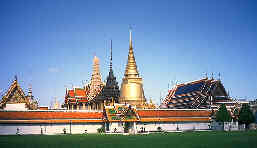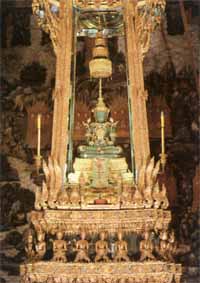

Emerald Buddha (Wat Prha Kaeo)
 Wat Phra Kaeo
(Wat Phra Si Rattanasatsadaram), in English called the Temple of the Emerald Buddha, was built as Royal Wat
early in the reign of King Rama I (reigned 1782-1809), founder of the Chakri Dynasty, who established Rattanakosin (the inner part
of Bangkok) as the capital of the kingdom in 1782. The
Wat, completed in 1784, occupies its own compound within the Royal
Palace area as did Wat Phra Si Sanphet in the former capital, Ayutthaya. The
temple (Wat Phra Kaeo) is a treasure house of Thai arts, and houses the Emerald Buddha, the most revered Buddha image in Thailand.
It is the most revered temple in the city, but being the royal chapel no monks reside there. It serves as the center for all religious rites pertaining to the state and
monarchy, such as ordinations under royal patronage, special ecclesiastical rites, and the swearing of fealty.
Wat Phra Kaeo
(Wat Phra Si Rattanasatsadaram), in English called the Temple of the Emerald Buddha, was built as Royal Wat
early in the reign of King Rama I (reigned 1782-1809), founder of the Chakri Dynasty, who established Rattanakosin (the inner part
of Bangkok) as the capital of the kingdom in 1782. The
Wat, completed in 1784, occupies its own compound within the Royal
Palace area as did Wat Phra Si Sanphet in the former capital, Ayutthaya. The
temple (Wat Phra Kaeo) is a treasure house of Thai arts, and houses the Emerald Buddha, the most revered Buddha image in Thailand.
It is the most revered temple in the city, but being the royal chapel no monks reside there. It serves as the center for all religious rites pertaining to the state and
monarchy, such as ordinations under royal patronage, special ecclesiastical rites, and the swearing of fealty.
The image of the Emerald Buddha is regarded by the Thai people as the palladium of the kingdom, just like statues of Pallas Athene were regarded as protectors of cities and states in ancient Greece. King Rama I brought the image from the palace in Thonburi, the short period former capital on the west bank of the Chao Phaya River. It was placed in the Main Assembly Hall (Bot) of the newly-built Royal Chapel and has remained there ever since. The "Emerald Buddha" is carved from a block of jade. It is an object of national veneration and crowds come to pay respect to the memory of the Buddha and His Teachings on certain days of the weeks when it is open to the public.
During its two hundred years history, the chapel has undergone several renovations, restorations and additions to its edifices. Extensive restoration and additional construction were carried out in the reigns of Rama III (reigned 1824-1851) and Rama IV (Mongkut, reigned 1851-1868). The latter's task was completed by his son, Rama V (Chulalongkorn, reigned 1868-1910), in time for the Bangkok centennial celebrations in 1882. Further renovations were made by Rama VII (Prajadhipok, reigned 1925-1935) on the occasion of the city's 150th anniversary in 1932.
A renovation of the entire temple was undertaken in the present reign of Rama IX, King Bhumiphol Adulyadej, to commemorate the Rattanakosin (Bangkok) bicentenary in 1982. The Royal Chapel thus incorporates no less than two centuries of Rattanakosin craftsmanship and artistic ingenuity.
Three main buildings inside the temple which form up a glittering scene are the Golden
Stupa, enshrining the relics of the Buddha,
the Royal Pantheon which is a pavilion used for keeping statues of deceased kings of Chakri
dynasty, the Phra Mondop or the Library, housing the Tripitaka or a Buddhist scripture,
. Besides, the 178 section mural paintings which depict the story of the Ramayana are the superb masterpiece of Rattanakosin artisans.
 Once you are past the entrance, you will see to your left a large golden Chedi
(Golden Stupa) on a platform, and in front of you the back of the large chapel (Bot) with the Emerald Buddha ("emerald" means
"green", the statue is in reality made of a single piece of fine green
jade). It is a surprisingly small dark green figurine (only 75 centimeters high) sitting under a golden filigree canopy on a high
throne. The Bot (chapel) is a splendid building with a red and blue three-tiered roof that rests on high
columns that are like the walls covered over and over with blue and golden
faience ornaments. Other noteworthy buildings are the Phrasad Phra Tephidon
(Royal Pantheon), crowned with a high filigree Prang (which contains the relics of the previous kings of the Chakri dynasty), with
lovely mythical Khinaree (half man, half bird) statues in front of it, and Ho Phra Montien Tham (or
Damma), the supplementary library. This library houses the temple's copies of the holy scriptures and has especially attractive doors with mother-of-pearl
inlays. The main library has recently been renovated . And
don't miss the murals in the galleries that enclose the temple complex. These lovely paintings depict scenes from the Thai Ramayana
(Ramakien) Epic. The pictures are unbelievably vivid and detailed and show besides the heroic tale of Rama and his war against the giant king lots of fascinating vignettes from life in ancient
Thailand.
Once you are past the entrance, you will see to your left a large golden Chedi
(Golden Stupa) on a platform, and in front of you the back of the large chapel (Bot) with the Emerald Buddha ("emerald" means
"green", the statue is in reality made of a single piece of fine green
jade). It is a surprisingly small dark green figurine (only 75 centimeters high) sitting under a golden filigree canopy on a high
throne. The Bot (chapel) is a splendid building with a red and blue three-tiered roof that rests on high
columns that are like the walls covered over and over with blue and golden
faience ornaments. Other noteworthy buildings are the Phrasad Phra Tephidon
(Royal Pantheon), crowned with a high filigree Prang (which contains the relics of the previous kings of the Chakri dynasty), with
lovely mythical Khinaree (half man, half bird) statues in front of it, and Ho Phra Montien Tham (or
Damma), the supplementary library. This library houses the temple's copies of the holy scriptures and has especially attractive doors with mother-of-pearl
inlays. The main library has recently been renovated . And
don't miss the murals in the galleries that enclose the temple complex. These lovely paintings depict scenes from the Thai Ramayana
(Ramakien) Epic. The pictures are unbelievably vivid and detailed and show besides the heroic tale of Rama and his war against the giant king lots of fascinating vignettes from life in ancient
Thailand.
How to get there
The complex is open daily 8:30-12:00 and 13:00-15:30. Admission fee is 200 Baht. (including a ticket to Vimanmek Royal Mansion). Proper attire is essential - no shorts, sleeveless shirts or shower thongs. Telephone - 2220094, 2226889, 2222208.
You can go to GRAND PALACE and WAT PHRA KAEO (Emerald Buddha) either by taxi (ask the concierge of your hotel to write down the name for you and do not forget to take a business card of the hotel itself), the taxi will drop you off at the main entrance. Or you can go, which is a lot more fun, by Express Boat. Take the boat at Oriental or Si Phraya (River City) pier and ask the fare collector for a ticket to Tha Chang (Chang Pier). The fare is only 7 Baht. if you arrive by boat, just walk from the pier to the road - there are many interesting food stalls - and then straight ahead until you can see the white palace walls (it is only a three to five minute walk). Take care - you will not be admitted by the guards if you are not properly dressed, which means long pants and a shirt with sleeves for men, and either pants or a knee-covering skirt and a "decent" blouse for ladies.
Copyright © 2000 - 2002 HelloSiam.com All rights reserved.